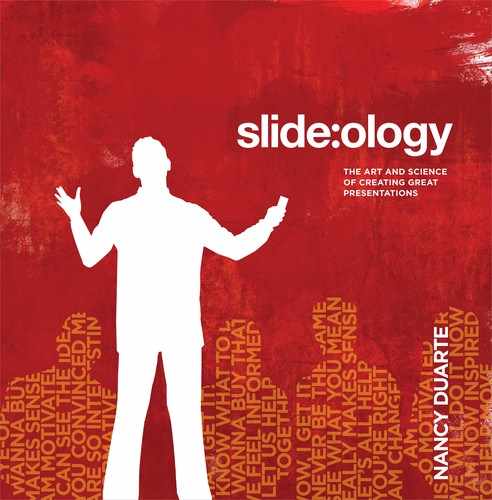186 slide:ology
Taking Lessons from the Movies
So, if you’ve decided that animation will help convey your
message, you can learn some lessons from the movies.
Interestingly, now that presentation applications incorpo-
rate animation and video, you are, in a way, sitting in the
director’s chair.
Over the last hundred years movies have relied on visual
language to tell stories and evoke audience emotion. For
a crash course in the principles of film language, take a
look at Jennifer Van Sijll’s best-selling book, Cinematic
Storytelling. In it she says, “cinematic storytelling is
the difference between documenting and dramatizing,
between employing the potent storytelling tools in the
medium or leaving them silent.” That same insight applies
to presentations. You can create either a document or a
dramatization. Many of the cinematic techniques in Van
Sijll’s book will inspire you to approach presentations
more like a screenwriter than a speechwriter.
A screenwriter’s ability to envision the story is what differ-
entiates them from other writers. Successful presentation
developers not only focus on the content but should be
fluent in conveying what the audience sees on the screen.

Comfortable
Uncomfortable
Descent easy
Ascent difficult
x-axis y-axis difficulty of movement
Creating Movement 187
1 Easier
2 Easy
3 Hard
4 Harder
Van Sijll’s insights into how the “dynamics of the frame”
affect movie goers applies to presentations. Here is her
fascinating take on how screen direction can impact audi-
ences and contribute to the story.
The eye is comfortable moving left to
right because it mimics reading. The eye
is less experienced moving the opposite
direction and is thus less comfortable. In
the movies there’s a good chance that
the “good guy” will enter from the left
every time. Conversely, the antagonist
usually enters from the right. This subtle
irritant directs audiences to see the char-
acter negatively.
A downward moving object is sensible
because of the law of gravity; it is natural
for things to descend. Conversely, an
upward moving object seemingly resists
gravity and is therefore illogical.
Once a downward motion starts, it’s hard
to stop without the object landing on, or
colliding with something.
Gravity aids the motion of descending
diagonals. The descent seems easy.
The left-to-right seems like an easier
descent because it follows the direction
of reading.
Gravity works against the ascending
diagonals. It’s easier for an object to
fall downward than move upward. The
right-to-left ascent is the most difficult
of all screen directions because it is
counter-intuitive to the reading eye
and works against gravity as well.
..................Content has been hidden....................
You can't read the all page of ebook, please click here login for view all page.
